Entries tagged with “design”.
Did you find what you wanted?
Thu 9 Aug 2012
So I’ve been thinking about what exactly I want to do with the theoretical knitting idea (besides come up with something to talk about that does not involve how many stockinette stitches I have knit this week!). Mostly, I think I just want a place to capture ideas outside of my design notebook, and to make for more interesting writing that will keep me coming back to chat on the blog, even amidst all the craziness of fall.
Also, I find it really helpful to have a reason to think up new ideas. Design is one of those things that works best when the pump is primed, and if you wait too long in between it gets harder and harder to come up with things. Â Ideas breed ideas, and before you know it you’re drowning in them. It’s a cruel cycle, really: you’re only coming up with thousands of designs when you already have too many projects and not enough time to do them. If you’re able to capture those ideas when they’re flowing, then they also manage to carry you through the dry spells when your creative powers are needed elsewhere. It’s no coincidence that I’m still knitting projects that I dreamed up in Germany, back in 2009. A tiny hint of a knitting idea can go a long way.
I spend some time curating photos for color inspiration in the same way; when I see something I love, I put it on Pinterest, and save it for a rainy day, or just a day when I have time to dye but no specific ache in my soul for a particular color. I am beginning to get quite a collection, and I can always find something to spark my interest, no matter what my mood. (This is my one and only use of Pinterest, lest I fall into yet another rabbit hole.)
A week or so ago, I was on a color-gathering spree, and came across this photo of an octopus:
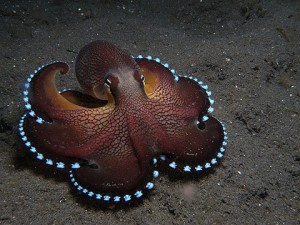
I have looked around for proper attribution, but the best I can come up with is a tumblr link. I’d love to know where it came from, because I bet that photographer has a million other things I’d love to pin.
I was drawn to the picture first because of the colors, which are not altogether unlike these:
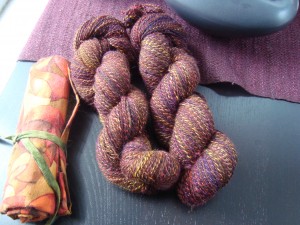
I am fascinated by the mix of orange and purple near the head, and those brilliant spots of white right at the hem.
That last bit got me thinking. The hem.
Wouldn’t his skirt make a beautiful shawl?
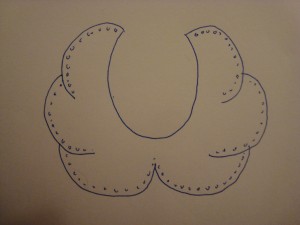
I’ve drawn inspiration from sea creatures before; they are masters of using simple design to create flowing, graceful structure. Nature has an excellent eye for proportion.
Now the question becomes how you would achieve such a thing in knitting. Those strong rib lines made by the octopus legs would work beautifully to space out the rapid increase and decrease sections needed to get the curved shaping. (On a related note, there’s an excellent discussion of how to make or avoid scallops in a knitted hem on the Rainey Sisters’ blog, where I have been lurking lately.)
But then, I think I’d want to knit the body of the shawl in stockinette, and knitting enough stitches in those long final rows to make that many scallops might just kill me. So what about short rows? That would let you keep that stunning contrast row right at the end, and would allow it to continue up into the body of the shawl the way those white dots follow the edge of each scallop right up into the body of the skirt. It would also break up the stitches into much shorter, more manageable rows.
Then I stopped and really looked at my sketch. Each one of those scallops is really just a half circle, stacked on top of the last:
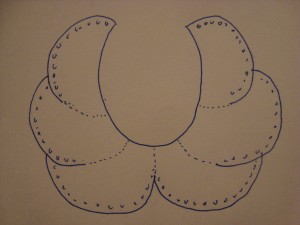
What if you started at one end, knit a small semi-circular shawl, worked the contrast edging, and then picked up stitches and continued on with the next?
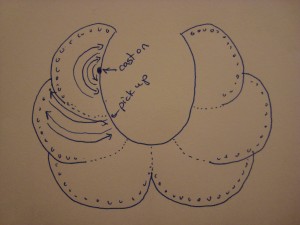
You’d work your way around the shawl, adding scallops as you went. No super long rows, and very simple knitting. You could do so many different things with the colors, too. Imagine this knit in a gradient yarn, or with two highly contrasting stripes to emphasize all those graceful curves.
Of course, this is the part where the practical side of me steps in and demands to know whether I would ever wear such a thing. This is one of those garments that falls into the questionable category for me, though I am rather smitten with the design. It’s a lot like the striped shawl sweater: a little bit of a stretch in the attention-grabbing department. (For the record, I love my finished striped shawl sweater, and wear it all the time.)
On the one hand, the shawl could be a beautiful, eye catching design. On the other hand, you might end up walking around looking like an octopus with a slightly shrunken head. You know – the usual fashion risk.
For now, the practicality likely doesn’t matter, given that this is theoretical knitting after all. Still, I think this is an idea that might be worth coming back to. It smacks of promise, and I do really like those curves.
Fri 29 Jun 2012
I may have mentioned that knitting time has become commute time. I can usually only knit for about half of the trip, since the second half is on a more crowded subway train. Still, I am getting quite a bit of knitting done. I’m thinking of counting my commute time in sweaters knit rather than hours. Behold the results of this week:
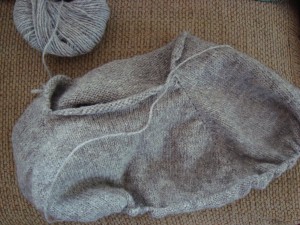
That’s the top of a raglan sweater, a little hard to see in its crunched-up on the needles state. This is the yarn spun from the Harriet fleece that I’m making for Mike’s sweater. I’m about half way to the sleeve split, I’d say. I ended up having to go down to size 2 needles to get the fabric I wanted, but the knitting is pretty fast anyway since it’s all stockinette.
So fast, in fact, that I need to get some spinning done before I can continue. All of the Harriet fleece is spun already, but I’m a little short on yardage and so decided to make a wide band at the shoulders with some of the leftover MacGyver yarn from Branden’s sweater. That was all fine and good, until I went and found the MacGyver yarn and realized that it was spun at a heavier weight.
I thought that the two yarns were about the same, but never did any sampling to check because I wasn’t originally planning to put them together. When I looked at the two yarns, they are very clearly different.
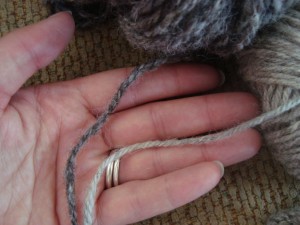
Comparing the gauge of the two sweaters, I am pretty sure I’d have distortion around the stripe if I were to use the MacGyver yarn directly. What to do?
Well, it occurred to me after thinking about it for a while that I’ve never tried yarn reconstruction. I’ve heard of others splitting yarns up into individual plies and respinning or repurposing them, but it’s not yet in my bag of tricks. It then occurred to me that it should be.
So, I unspun my three ply yarn by running it back through the wheel, and then wound the three plies onto separate bobbins. Then I took two of them and plied them back together, to make a yarn that really is very close to what I’m going for.
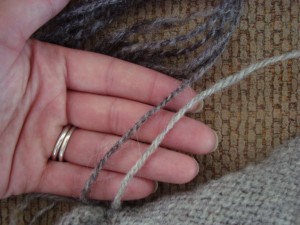
I now have one skein of yarn unplied, and am working on winding those live singles onto separate bobbins. It was a lot easier in my 6-yard sample than it is for a whole skein, but it is slowly progressing. I’m thinking I’d better hurry up, or I’m not going to have knitting for my commute next week!
Sun 15 Apr 2012
The final countdown is on…we leave for the show on Thursday. I have quite a pile of fiber (about 150 braids) waiting patiently in boxes, a basket full of sample skeins and sweaters spun from hand dyed and spun yarn, and today I have one more sweater to add to the pile:
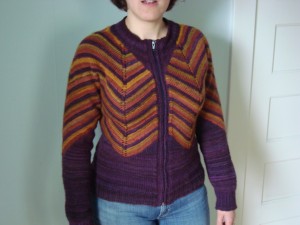
The striped shawl sweater (which really needs a better name) is done. I finally finished the zipper this afternoon, and now it just needs its second and final blocking.
I am mostly happy with how it came out. I like the design itself even more than I thought I would, but it came out a little bit too tight around the waist and hips because of a couple of extra decreases that would have been better left out. I tried it on after blocking for the steek and it seemed to fit just fine, but wearing it around the house today I can tell it’s still a little tight. Between that and the way this construction stretches, it tends to ride up just a touch. You can see that a little bit in the back.
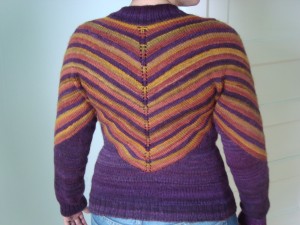
There’s a tiny bit of a crease at the point of the triangle, and a bit of bunching under the arms. Both of those go away with a little bit of tugging, though, so I’m hoping that it will relax out with the second blocking. An extra inch would take care of both. Or, I could always just wear it open.
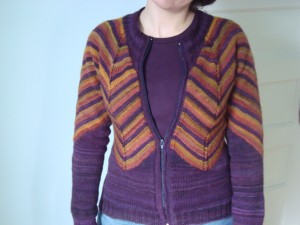
I very much like having the power of steeking in my toolbox. This is my second steeked sweater in a row now, and the first where I picked up stitches and knit a button band (the purple stripe around the zipper is picked up and knit). I’d show you close ups, but my camera ran out of battery and refused to take any more pictures, so that will have to wait for another day.
I wanted to try a crochet steek on this sweater, but found out that that method shouldn’t be used close to the end of a row. Since all of my color changes happened in that front band, I decided to stick with a machine-reinforced steek instead. I ended up using two rows of machine stitching, and then just folding it over and tacking it down. There’s a piece of grosgrain ribbon attached to the zipper inside to help protect the raw edge, and it looks very secure to me. I’m already working away on the next sweater design, and I suspect that it may also have a steek. I have quite a few pullover sweaters now, and am really looking forward to having these new cardigans in my wardrobe. (Bright lights has been getting a ton of use, now that the weather is starting to warm up a bit.)
I’m happy to have the striped shawl sweater finished in time, because I think it will make a fun sample for the show booth. It’s a good example of what you can do to mix different handpainted colors into a wearable garment. The sweater is one of the lightest I’ve made, weighing in at 1 lb, 1 oz. It took 5 braids of fiber because I needed just a little more purple to finish the body.
Linda and Walden have been knitting away at their test knits for the shawl version of this design. You should go take a peek; it’s really interesting to see how the different yarns and colors highlight the geometry of the increases. I can’t wait to see how the final versions come out!
I also finished spinning up a sample of the new Rambouillet for the booth.
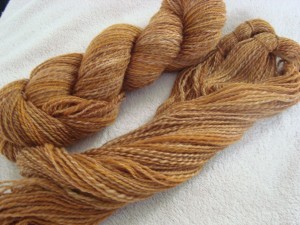
I ended up with about 470 yards of 2-ply fingering weight. Somehow I am still having trouble breaking through that fingering-to-laceweight barrier. I’m not sure whether to blame it on the wheel or on myself, but my best attempts at a fine yarn have all been coming out in this range, even using the smallest whorl on the lace flyer. It’s just difficult to get enough twist into the yarn to keep it fine. Some sections of these skeins are in the heavy laceweight range, though, so I think there may be some hope of figuring out how to go finer yet.
This color isn’t one that I would usually gravitate toward on its own, but I am itching to use it. The words “leaves of grass” are all I can think when I look at those skeins, and I’m thinking it will turn into something lacy with a wheat-ear theme. Time will tell, though. The Rambouillet spins like a dream and puffs up into a beautifully fluffy yarn, and I have a feeling that it will bloom even more after it’s bath. It’s upstairs drying right now, so we’ll know soon!
Sun 25 Mar 2012
The striped shawl sweater has been slowly creeping slowly forward with the same knit-rip-knit pace. I’m past the striped section and have been working short rows to transition into the main body color. I started out decreasing one stitch for every three rows that I knit, which looked pretty good at first, but looked less good as the fabric grew. I worked short rows for both of the sleeves and half of the body before deciding that it looked a little too puffy.
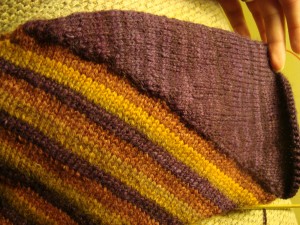
See how there’s a bump at the edge of the dark fabric? Well. It was bothering me. So I ripped it out, and reknit the short rows, decreasing one stitch for every 2 rows instead.
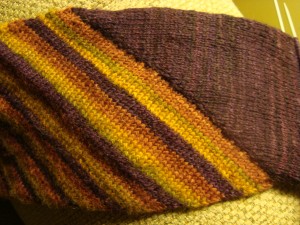
Isn’t that better?
I’ve since redone the short rows, and finished the main body section. I had to spin some more yarn to make it, but I am very happy with how it’s coming out.
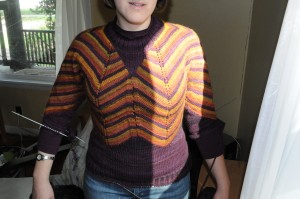
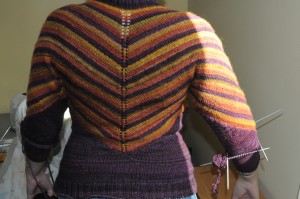
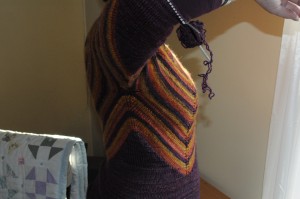
I am to the elbows on the sleeves and I am running on yarn fumes, so I’ll need to spin up another hundred yards or so to finish it off. I hadn’t counted on the short row decreases to add so much shaping, and I added a few of my own, which turns out to have been unnecessary. The final fit ended up a tiny bit tighter than I’d like, but I think it will loosen up with blocking and I don’t think it’s enough of a problem to rip back again. This project may finally be in the home stretch. All that’s left is finishing the sleeves, and then steeking the front to install the zipper. It’s getting close!
While I’ve been knitting the striped shawl, I’ve been keeping my spinning wheel busy finishing up the green for the fall colors sweater.
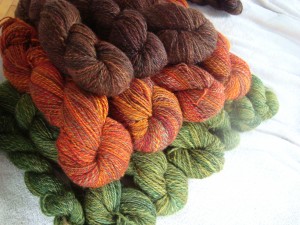
It’s all finished now, and will be ready to go as soon as I settle on a design. I’d like to say that it will be simple to make up for the last, but somehow I think that’s unlikely. (I’m still leaning toward the last design in this post, which will involve both steeking and a little bit of tailoring, and I’m thinking it likely that it will also have some rather experimental colorwork going on. Never a dull moment around here.)
Amazingly, that brought me to the end of what had seemed like a very long spinning queue, and suddenly it was time to start spinning the wool for Mike’s sweater, months earlier than I had planned. He’s a close friend of ours, and I think this may officially be the first big thing I’ve knit for someone outside of the family (mostly I knit just for Branden and I). We usually stay at Mike’s house over Christmas, and he was especially taken with Branden’s MacGyver sweater this year. He kept asking how long it took to make a sweater, from spinning the wool through to wearing it. I didn’t know, but I’ve decided to find out by spinning up the rest of the Shetland that I bought from that farm. Since Mike is also of an engineering bent and loved the MacGyver angle, I’ll also work in some of the leftover MacGyver yarn, probably as colorwork or stripes around the shoulders. For now, I’m spinning some wool from Harriet:
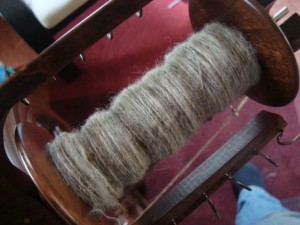
Doesn’t she have a lovely fleece? I liked it well enough in the roving, but it wasn’t until I started spinning it that I realized how beautifully heathered the gray is going to be. I have to admit that I have been struggling to resist the temptation to claim this wool as mine (as it was originally intended to be), but I am going to stick to the current plan. There will always be more fleeces, and I am getting to have a lot of sweaters!
One thing that has been very interesting about this set of projects is spinning from three fleeces from the same farm. You’d think they’d be pretty similar, given that they are three sheep fed and coated the same way, living in the same flock. The wool was presumably sheared by the same shearer and processed by the same mill. But the fleeces are not the same. As a reminder, MacGyver’s is the light gray wool in the sweater, and Magnolia’s is the dark brown.
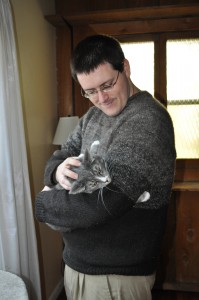
MacGyver’s wool was kind of downy, but had lots of heavier guard hairs in it. I tried picking them out as I went, but enough stayed in to make the sweater slightly prickly when worn on sensitive skin (fortunately, Branden doesn’t mind). As Branden has worn the sweater, the guard hairs have tended to poke out here and there, and we’ve been pulling them out over time. I’m not sure that it’s making much difference, but I like to think that the sweater is getting softer and softer with time. Either that, or we’re helping it to fall apart faster, but I’m sticking to the first interpretation. MacGyver’s was the first wool of the three that I spun, and it was full of little pills of short fiber, like the wool had been slightly tipped or there were second cuts in the shearing. I must admit that I was not looking forward to spinning three big bags of wool like that; pills in the spinning make me crazy. But the fiber was beautiful otherwise, and I loved the yarn, so I kept spinning.
Magnolia’s wool had none of the pills, and none of the guard hairs. It was a much thicker feeling fiber, very smooth and greasy, almost like alpaca. The pills must have been from MacGyver and not from the mill, since both Magnolia and Harriet’s fleeces are pill-free. Harriet’s fiber is different yet again. It is much lighter than Magnolia’s and very soft, Â more like the downy fleece in MacGyver’s wool. There aren’t many guard fibers at all, though there is a lot of hay. Harriet loved to wear her hay. I pull little bits out as I’m spinning, and I can’t help but imagine this sheep standing by her hay bale, munching away, pulling it down on top of her shoulders. Fortunately, most of it pops right out while I’m spinning, so it’s not a big deal, but it does amuse me to think of how this sheep must have always been wearing her food.
While I knit one sweater and spin toward the next, I’ve also been taking advantage of the beautiful weather to get outside and comb some more of my Gulf Coast fleece from last year. It is slow going, preparing a whole fleece by hand. I spun up most of what I had combed at Christmas to give to a friend, and I’ve only done a few ounces since then. It will be quite a while before I work my way through the whole 2.5 lbs, but it is very satisfying to see my bag fill up with these airy little puffs of fiber.
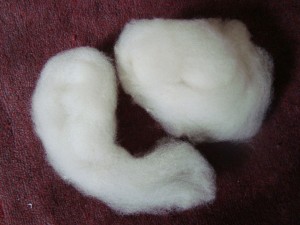
So there we have it. Handspun wool in all its stages. (Now all I need is a sheep.)
Fri 24 Feb 2012
I am yet again building up a list of small things going on behind the scenes that never quite make it to the blog. I think it is time for a catch up post.
Item the first:
I joined a new spinning group last month, and they have monthly workshops. I wasn’t terribly excited about the January meeting, because I’ve never been at all interested in needle felting. But I’ve found that one of the best things about being part of a group is trying things you wouldn’t otherwise do, so I went anyway. And I have to say I was pleasantly surprised. The poke-poke-poking went a lot faster than I had thought it would, and in the right frame of mind it’s even kind of relaxing. And, I really like the results:
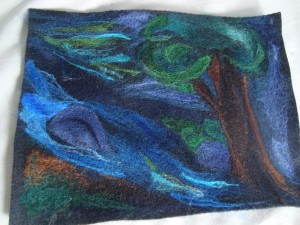
I doubt that I’m going to convert instantly to a needle-felting junkie, but it was just the right thing for my recover-from-interview  days last week. So, I started a flower.
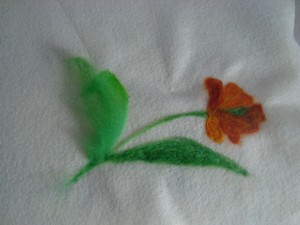
The nice thing about needle felting is that it finally gives me something to do with all the bits and pieces that I pull of of my fiber when I’m braiding it for the shop. There are always a few little pulls here and there, and the ends usually get a little felted, so I end up with a small handful of fiber from almost every colorway I make. I’ve been putting them aside as too good to throw out, and now I have quite a fun palette.
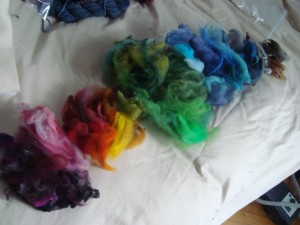
Moral of this story: Never assume that you are immune to any fiber craft, no matter how improbable it seems. (At least not if you’re me.)
Item the second:
The striped shawl sweater is now behaving beautifully. There were an awful lot of big bumps getting onto this road, but now that I’m on it I think it’s going to be much smoother. The points in the front are falling exactly where I expected them to:
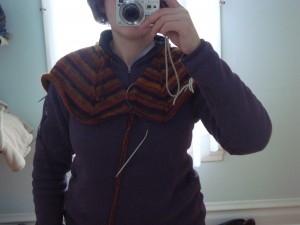
And the back is also laying nicely now.
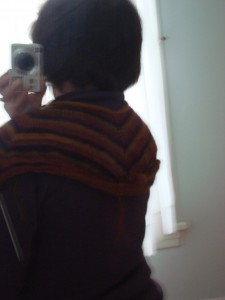
I’m not quite to the arm split yet, but if we get there without any more bumps in the road, then I think we’re home free.
Item the third:
I also finished spinning up the first “extra” skein of yarn for the main body of this project. I wasn’t sure how it would turn out, considering that I’d dyed the two batches of wool over 2 years apart.
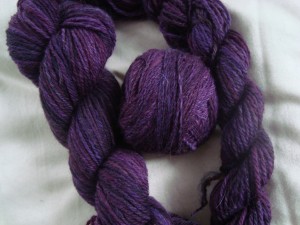
The ball in the middle is the old skein. The two on the sides are the new. I think that’s a pretty good match, don’t you?
I’m hesitant to attribute that to anything other than dumb luck, but I am pretty thrilled that I managed to get more of the same colorway after all this time.
Item the fourth:
Since I have now fully accepted that the striped shawl sweater is in fact going to be a sweater and not a shawl, that means that I have no good excuse not to just finish the shawl and be done with it. I sat down with my stitch dictionaries, and almost immediately stumbled across the perfect edging in Knitted Lace of Estonia. I spent days and days looking for border patterns last time I was working on this shawl, and this time it just fell into my hands. I’m taking that as a sign.
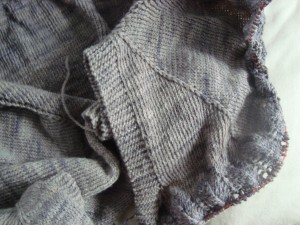
Unfortunately, each row takes about 45 minutes to knit, so it’s not exactly flying off the needles. Still, it’s making progress, and it should be ready to bind off soon. Yay for finished objects!
Item the fifth:
I was in need of a project that felt like it was going somewhere, so I whipped up a little instant gratification last weekend. I had just finished spinning up my sample of the Rambouillet top, with the aim of making a hat for Branden. It really doesn’t take long to knit a hat in worsted yarn, especially when it’s just a simple, simple hat with a little short row shaping.
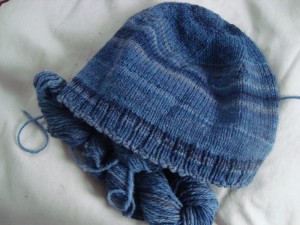
I was hoping for a modeled shot, but that’s why it hasn’t been blogged yet, and I bet you can imagine what a hat looks like on a head. I tried taking photos in the mirror, but it’s amazing how hard it is to take a picture of your own head.
I love how the colors came out on this one. They’re a tad bit greyer than they look in the photo, but I love those stripes. I ended up with about 220 yards of yarn, and the hat took almost precisely half. There should be enough left for a pair of handwarmers, too.
Item the sixth:
I have finished the first sleeve of the lace ribs sweater. I have no idea why this is taking me so long, besides the fact that I just don’t love knitting pieces flat. I usually do everything in the round, but the lace needs seams to keep its structure, and so it must be knit flat. Somehow, this is just never the project that I pick up first.
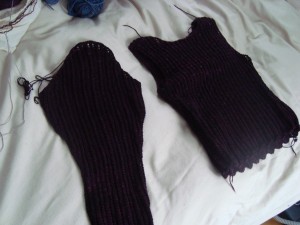
The good news is that the charts and instructions are almost done, so as long as the sleeve is actually the right size and shape after blocking, I should be almost done with the pattern.
The last item isn’t really an item, so much as it is something on my “must-catch-up” list. If I don’t get this fiber wrangled soon, it’s going to eat my office.
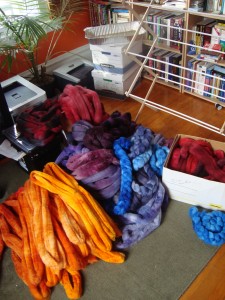
That is something like 48 braids worth of fiber. Those bankers boxes you see in the background? Also fiber, stuffed full to bursting. The stuff on the floor is waiting for photos and Etsy posting. Branden’s robotics team shipped their robot on Tuesday, so hopefully it will be a little easier to find time to take photos soon. (It’s kind of hard to find daylight picture time when he’s gone 4 days a week from morning until after I’m in bed, and at least half of the day on Saturday.)
Yellows and browns are next, but I’m holding off until after this batch is done. I don’t want to get swallowed up by the stash!
We’re almost all the way to a full rainbow now. I can’t wait to put them all together and see the full spectrum. And then, when the semisolids are done, I get to go back to the variegated colorways. So. many. ideas!
Sun 19 Feb 2012
This has been a busy week, but today I finally managed to sit down and draw up some new sketches for the striped shawl sweater. I’m in need of some mindless knitting, and there will be lots and lots of that once this design is actually on the right tracks (I think this time will be the charm). Since you are all so good at humoring me in my process posts, I thought I’d share the changes that I’m making.
(Incidentally, if you’re hoping for a pattern, you’ll note that the last sketch is really all you need. This whole design is all about putting double increase lines in the right place; after that, it’s just guessing how many stitches to cast on. I do plan to write this up as a pattern eventually, but who knows how long that will take…if a “recipe” is all you need, here it is.)
This is the sketch of the original verison:
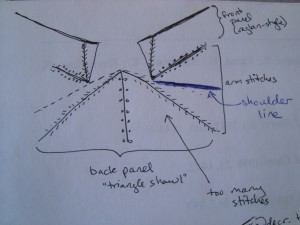
You can see that there are two different kinds of increase rows that define the main lines of my pentagon. If you squint, I think you can see them here (look for the yo lines, which are the ones with dots in the drawing above. The point of the shawl back is made up of yos).
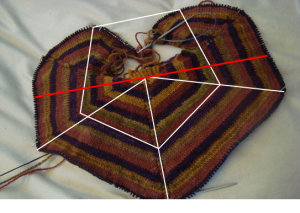
As we saw before, this led to too many stitches in the back panel, and I’ve decided that this is best fixed by changing the position of the shoulder line (shown in red on the photo, and in blue on the drawings):
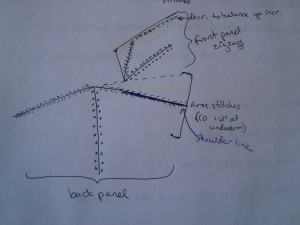
By rotating that shoulder line onto my double lifted increases (the line with the slashes), I got this:
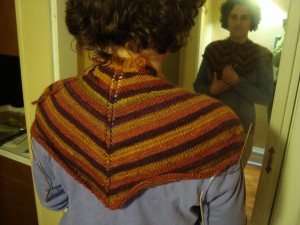
I’ll keep that increase line as the top of the shoulder and sleeve, which means that there will be more fabric to deal with in the front. It also means that those front yos fall naturally into position for the zigzag style.
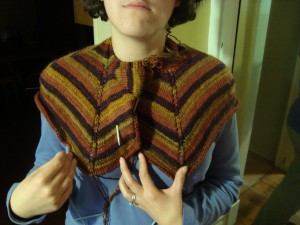
…which means that I just have to add decreases at the edge of the front panel to balance the increases that I’m adding from the yo column. (You can see that the fabric is folded over in the photo above to look like two separate front panels.)
This is also the part where I need to decide what to do about the neck. As you can see in the back shot above, rotating that shoulder line makes the back of the neck very high; it’s several inches above where it would normally be.
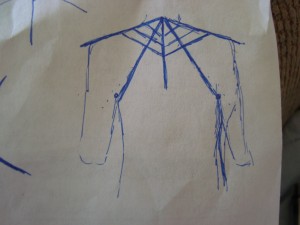
That’s not necessarily something that I mind, since I’m always cold and usually want something to cover the back of my neck anyway. But I’m thinking that I will probably eliminate the first full stripe repeat, and make my cast on sit at the beginning of that second purple row. That will be a more “normal” fit to the neck, and I think it will help with the fit in the front. You can see that the fabric is sitting a little funny at the front shoulders in the zigzag picture, and I think that cutting out that extra back neck will take care of that.
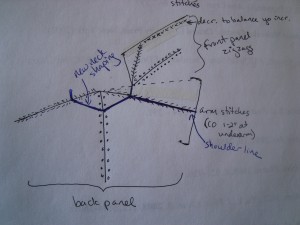
I’m also planning to eliminate the knit-on garter stitch edging, and instead plan to pick up and knit stitches to finish the collar. That gives me a lot more choice later to decide what I want the final collar to look like.
The last question is whether to keep that small triangle at the neck edge of the front panels. I really like how it wraps the stripes around and brings them vertical again, but I’m not sure how much of that will be preserved with the structural changes in the neck shaping. If I leave out that last set of lifted double increases, then that triangle will be eliminated, and I’ll have a v-neck opening something like this:
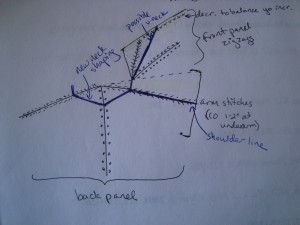
That would make a pretty deep v-neck, and the two front panels would probably meet right around the bra strap. Both Branden and Ellen suggested some kind of flap or lapel front, and this seems like the best option if I’m going to incorporate something like that. I’d probably use a solid purple to match the hemline, and just pick up stitches to add it on at the end. It would add another diagonal line to the front panel, and it might also cover up some of the zigzag look near the neck. It would decrease some of the busyness of the design by adding a solid area in the front panel, as Jocelyn (I think?) had suggested earlier.
I’ve been planning this as a zippered cardigan, so I want something that can be either open or closed, but I don’t think that a solid v would take too much away from the zigzags, especially if it came up into a high solid collar.
Making this change would mean that I’d lose those vertical stripes that I like so much, but I think that might actually be better considering how busy this design has become already. With all of those changes, I think the final sweater will look something like this (though the v-neck will probably end up a little deeper, and the shoulders will probably be a little more like a raglan and a little less like a set-in sleeve):
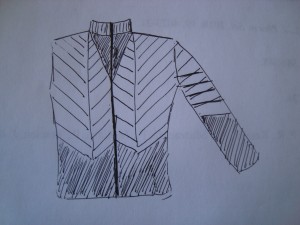
I think I like it.
Fri 10 Feb 2012
Insanity: Doing the same thing over and over again and expecting different results. Â ~Albert Einstein
After realizing that my latest “fix” has still not fixed the striped sweater, I finally sat down today to figure out what is really going on. I’ve been tweaking one thing after another, but clearly there’s something bigger going on that just isn’t working. Whenever I get to this point, it’s time to stop and reevaluate to see what I’m missing. Part of the problem is that I didn’t start this project expecting it to be a sweater, and so I hadn’t gone through all the design thinking that I’d usually do before casting on. So this afternoon, I sat down and looked at it very hard.
And I realized that it’s not a hexagon. It looks like a hexagon, doesn’t it?
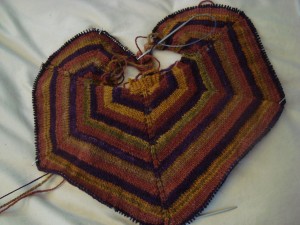
But it isn’t. Those angles are not 60 degrees. In fact, they’re much closer to 72 degrees, a fact which quickly explained all the problems I’ve been having.

Instead of splitting my fabric right down the middle, the shoulder line I’m using puts 3/5 of the fabric in the back panel. I had used a different shoulder line in the first picture:
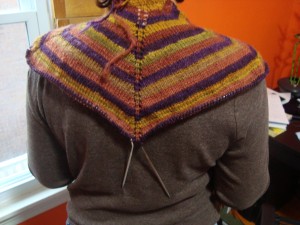
You can see that the first one has the increase line right along the top of the shoulder, but I’d moved it into a more traditional Raglan position in the later versions.
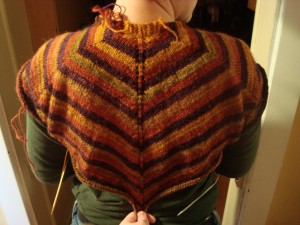
The Raglan line gave me a better fit on the neck, and would have been the perfect solution if I were working with a hexagon, since the stitches would have been evenly divided between front and back.
But I’m not working with a hexagon.
I’m going to have to pull back the latest fix anyway, but tonight I tried it on to check that changing the shoulder line is the right thing to do.

It is. The trouble is, moving the shoulder line puts all those extra stitches in the front, so now I need to figure out what to do with them there.
I’ll definitely have to cut a bunch of them out, but the question is: which ones?
I can take some stitches out of the shoulder area to preserve the pentagon shape and make Raglan shaping in the front. This is very close to what I was expecting with the previous design. The Raglan is a pretty safe option; horizontal stripes aren’t my favorite thing ever, but it’s a classic design and I know I won’t feel too obtrusive wearing it.
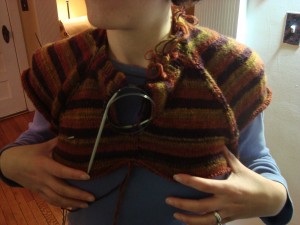
Or, I could take the stitches out of the front panel. I like the stripes going up over the shoulders in this one, but I’m not sure I like the front placket. Something in it feels very Pride and Prejudice to me (not that that’s a bad thing, but it’s not quite where I was expecting this design to go). Â Still, I think this one has the potential to grow on me.
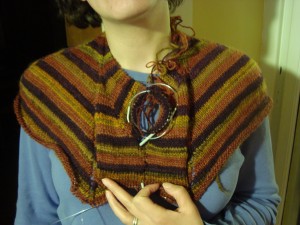
The last option is the one that has me most intrigued, but it also has the most potential to go wrong.

This is just another way of taking increases out of the front panel. I think the zig zag effect is interesting, but I’m not sure about adding two more “arrows” to this design in potentially attention-grabbing places. I’d continue the stripes down to mid-waist to match the back, which I think would reduce the arrow effect, but I really don’t know how I feel about this one. My first thought was that I absolutely didn’t like it (clown ruff, anyone?), the second thought was that maybe it wasn’t so bad, and now it’s kind of refusing to step aside.
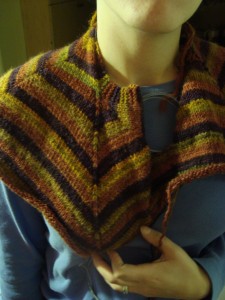
I like the look of it better when the front is open, and it does do a good job of highlighting the geometry.
Branden is strongly in favor of the zig zags, followed by the front placket, leaving the Raglan in last place. Raglan is low on my list, too, except that I don’t have to worry about whether or not I’ll wear it. The other two are still fighting it out in my mind.
Thoughts?
Sun 5 Feb 2012
I think it’s probably time for a knitting update, lest you think I have abandoned my needles completely. When we last saw the striped sweater, it had just been ripped back to here:

Then, I re-knit it to here:
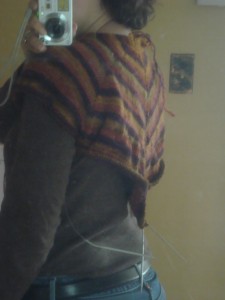
…and was disappointed to find that my fix hadn’t been quite enough. I’d left out one set of increases, but still ended up with too much fabric in that back panel. So, I pulled back to here:

and added a set of decreases as well. Now, it looks like this:

You can still see that there is a bit of a bulge at the armhole. I know how I’d go about fixing it, but I’ve been trying to convince myself to let it go. Unfortunately, as soon as I looked at this latest photo I knew that wasn’t going to work. When I’d last tried it on, the sweater was several inches shorter and the bulge was barely visible at all. Now that I can see how it knits out, I’m pretty sure I need to fix it. Good thing I like working with this yarn!
Pulling back will also give me an opportunity to fix another small thing that’s been bugging me.
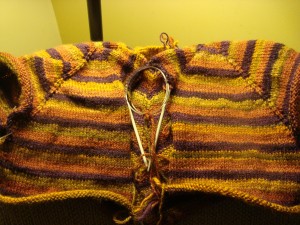
See how the color stripes aren’t quite lining up in the yellow yarn? (Sorry for the terrible photos.) The way I’m currently working, I knit 4 rows on one side, carry the yarn across, and knit 4 rows on the other side. That’s fine with the semi-solid colors, but it means that the more variegated yarn gets a little out of sync. It’s not the end of the world, and I probably wouldn’t mind it all that much in the finished sweater, but pulling back gives me a chance to switch to knitting in the round, which will make the front stripes match. This is perhaps going a little overboard in attention to detail, but then it’s the little things that make or break a piece, isn’t it?
This last attempt at least let me try out the geometry of short row shaping on the sides, which I rather like.
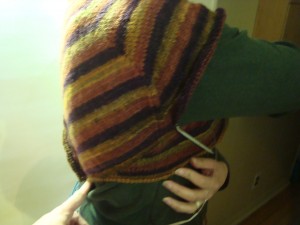
And, I like where the point falls in my back in the photo above, so I’m less worried about the arrow-ness of the triangle construction. I think that will actually work out really well when the sides are filled in with a darker complementary yarn. (Someday, provided I ever make it past the sleeve split.)
In the meantime, I have  a lot of non-fiber projects that feel like they’re not going anywhere at the moment, and last weekend I was really feeling the need to make visible progress on something. So, I put the striped sweater away for a few days, while I finished up the body for the new lace ribs sweater.
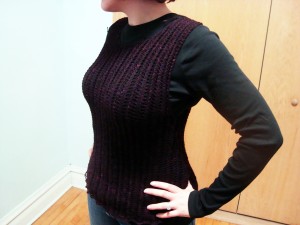
It’s not blocked yet, so it’s a little unevenly stretched, but I think it’s coming out well. The armhole is a bit bigger than I expected it to be, but I compared it with other cardigans in my wardrobe and I think it’s actually about right. In the past, I’ve often made my underarms just a little too tight, so I think I’m going to leave it this way, with plenty of room for a loose shirt underneath. I’m about half way through the first sleeve, and am polishing up the pattern and calculating sizes as I go. The sleeves should be finished up in the next week or two, as long as I don’t get sucked back into the striped sweater.
And now, I think I’m off to make some more progress by ripping back.
Wed 30 Nov 2011
I’m afraid I’ve been knitting and spinning more than I have been posting lately, and I am developing quite a backlog of things to tell you about. For tonight, I think we’re a bit overdue for an update on the Fall Colors sweater, yes?
Over the past couple of weeks, I have been turning this:
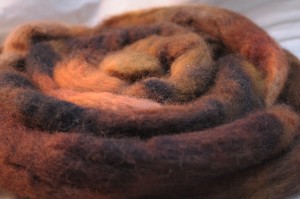
into this:
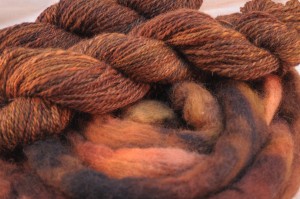
(Actually, I’ve finished all the brown, but I really liked the comparison of the original top and the final yarn.)
The Finn didn’t get at all sticky this time, and it has been absolutely beautiful to spin. It’s a nice fiber even when I get it wrong, but when I get it right, it’s amazing.
The colors also came out really well on this one. They ended up a little lighter than I expected in the final yarn, so I may have to overdye a bit at the end to darken it up a bit. I was expecting to get the balance shown in the first color; mostly dark with a few light spots for contrast, but it came out just the opposite. I’m working to come up with a design modification that will let me get around overdyeing it, though, because I really, really want to keep all those subtle color changes in the yarn. (I have been agonizing over this enough that there have even been suggestions that I should just dye up more fiber in a darker color and keep this yarn for something else. It is a tempting offer, but I think I can make it work.)
When I dyed this fiber, I knew that I wanted to match the original red-orange colorway. I used the same brown dyes that I had used to accent the red-orange fiber, and then added in a tiny bit of the orange and even a little bit of green. You can’t see it too well in the photo above, but it’s there. I was surprised to see how much that came across in the yarn. There are sections where one ply is a deep, olive green instead of brown, and a couple of spots where it lightens up almost to orange. I’m hoping that will help to tie the colorways even closer together in the final piece.
I used the same strategy for the green, dyeing it with the orange as a base dye and adding teal to make the green I wanted. Then, I threw in some dabs of brown here and there, and a slightly lighter green to brighten things up.
So far, I think they go really well together.
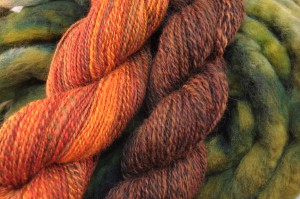
I started spinning the green at the Spinning Guild meeting on Monday. I can’t wait to see how it comes out!
Tue 22 Nov 2011
There comes a moment in every crazy project where you have to decide whether to dive in or whether to save your sanity and walk away.
I had to stop and consider when I got to this:
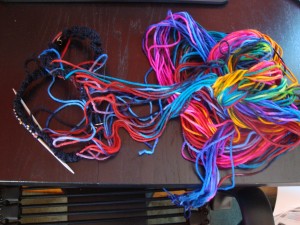
which was really only marginally improved by becoming this:
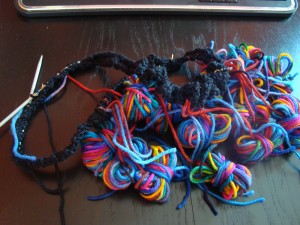
But then, I have visions of this to keep me going:
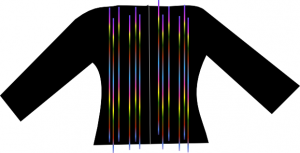
Sanity is overrated.























































